Michigan Beach Homes on Target for LEED Platinum & on SALE!
More details Here!
More details Here!
In today’s business, LEED is the language of green. is now offering USGBC curriculum, with the following upcoming courses:
HOMES 252: Understanding the LEED for Homes Rating System
HOMES 301: Implementing the LEED for Homes Rating System
Learn how to apply the LEED for Homes rating system by walking through the phases and key decision points of a typical project. Engage with experienced LEED® Faculty™ and other participants to work hands- on with LEED implementation strategies and rating system tools.
Course Objectives
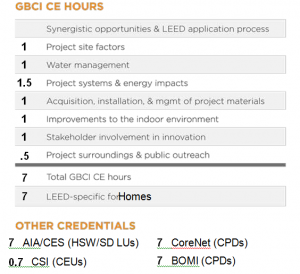 Communicate the unique aspects of LEED for Homes
Communicate the unique aspects of LEED for HomesFaculty
Taught by USGBC-trained faculty with real-world expertise and LEED project knowledge to share.
Where?
HOMES 301: Implementing LEED for Homes
October 21, 2011 – Detroit
8:30 am – 5:00 pm at 71 Garfield LLC
HOMES 301: Implementing LEED for Homes
October 28, 2011 – Indianapolis
8:30 am – 5:00 pm location TBD
HOMES 301: Implementing LEED for Homes
November 11, 2011 – Covington, KY
8:30 am – 5:00 pm at TBD
HOMES 301: Implementing LEED for Homes
November 11, 2011 – Chicago
8:30 am – 5:00 pm at Merchandise Mart
Reasonable sponsorship packages available. Inquire with for details.
EARLY BIRD RATE: $199 for registration before October 10.
STANDARD RATE: $249 for registration after October 10.
Pay via PayPal (PayPal account not necessary):
Pay by Check:
947 Wealthy St Se
Grand Rapids, MI 49506
Pay by phone: 616 – 458 – 6733
Questions? Contact Us.
The total cost was $1.6 million. That may seem like a lot of money, but if you look at any other custom-built house this big—it’s 2,675 square feet on a double lot in Chicago—it’s going to cost at least that much. Incidentally, the green materials generally were no more expensive than conventional alternatives.
ELLE DECOR: Why did you decide to build a LEED platinum house?
MICHAEL YANNELL: I wanted to set an example. I had been very frustrated with the construction I was seeing in Chicago. There are so many green options, but nobody was using them. People assume it’s too cold, it’s too cloudy, for solar energy. I wanted to show it could be done here.
ED: So it’s a kind of demonstration house?
MY: I’m not saying every house should be like mine. I’m saying, look at my house, take one detail, and start there.
ED: To accomplish that, you have to be willing to let the world see how you live.
MY: After I moved in I began giving tours constantly—usually an hour long, and limited to ten people, because there were always lots of questions. We started outside the house, and I explained the macro design of the home and then went room by room. I think people have been surprised by how beautiful the house is on the inside. I don’t know what they were expecting.
ED: So, give us the tour.
MY: The house is divided into two wings, so every room has a southern exposure. I think that’s a huge benefit, to not have any room be always dark. I never have to turn a light on during the day. In the winter months, it really has a beneficial psychological effect. The north side, by contrast, has only a few small windows—you’d lose too much heat otherwise.
ED: The solar panels all face south.
MY: Yes. But it doesn’t jump out as a house with solar tacked onto it. One of the things the architects insisted on was having as many of the solar panels hidden from view as possible. That’s one of the reasons the roof has that V shape. All the panels are on the north side of the V, and the south side of the V hides them from sight.
ED: How much did all this cost?
MY: The total cost was $1.6 million. That may seem like a lot of money, but if you look at any other custom-built house this big—it’s 2,675 square feet on a double lot in Chicago—it’s going to cost at least that much. Incidentally, the green materials generally were no more expensive than conventional alternatives. The big items were the heating and cooling systems. But you can take tax credits for 30 percent of those. So basically I won’t owe income tax for the next few years.
ED: How did you choose the finishes?
MY: Every material that went into the house has some environmental story. The exterior is a combination of durable fiber-cement board and Forest Stewardship Council–certified cedar, covered in a cocoa soy-based stain. I love the contrast of dark and light.
ED: And the interior finishes?
MY: In the south wing the floors are a dark brown recycled-porcelain tile, which is very earthy, very soft. In the north wing the floors are made from scrap lumber, which would have ended up in a landfill. It’s walnut, with a clear coat that gives it a warm, natural feel. In the bedrooms, I chose dyed-clay walls. Besides looking good, they absorb sound better than regular painted walls. And clay also absorbs humidity, which is a nice feature in the summer.
ED: Does the furniture have the same kind of environmental credibility?
MY: Much of it is steel, which is recyclable. That’s one of the reasons we bought a lot of furniture from Knoll. The house has a midcentury look, so Knoll was right up our alley. All of the fabrics are Greenguard certified.
ED: What about the art?
MY: We chose the work of a Venezuelan artist, Radames, who works with Plexiglas scraps. I liked the designs, but I don’t like Plexiglas, because it has a high petroleum content. So we asked if he could work with 3form, which is an eco-resin product. He came up with seven or eight pieces for inside and a sculpture for the backyard, so it’s a green art collection as well.
ED: Speaking of art, the house has gallery reveals—those subtle recesses where the walls meet the windows and door frames.
MY: We used reveals throughout the house. I had never even heard the term before. It became known as the “R-word” during the design phase. It added to the cost, but it was really important to the architects. I have to admit, I appreciate how good it looks.
What the Pros Know
Architect Jonathan Boyer, of Chicago’s Farr Assoc., says the house is designed to produce as much energy as it consumes. But, he adds, he knew it would get the point across only if it also looked good.
• Be flexible: Most of the materials were produced locally—a key green principle—but when he needed an attractive cement board, Boyer had to buy a European product.
• Do double duty: The butterfly roof provides shading in summer and optimal placement for the solar panels. The V shape collects rainwater, which is used for irrigation.
• Exploit technology: “Thanks to LEDs, we were able to flood the rooms with light,” says Boyer, “despite using fixtures so compact you hardly see them.”
Click here to see the gallery of the Home
Written by Fred A. Bernstein • Photographed by Tony Soluri • Produced By Susan Victoria
http://www.elledecor.com/home-remodeling/articles/design-solutions-sustainably-chic
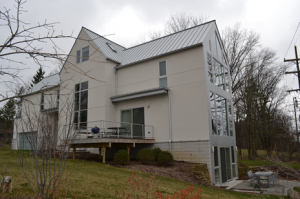 This home dramatically reduces it’s HVAC energy requirements by using airtight building principles. This home utilized geothermal forced air cooling and geothermal hydronic heating to further reduce HVAC consumption.
This home dramatically reduces it’s HVAC energy requirements by using airtight building principles. This home utilized geothermal forced air cooling and geothermal hydronic heating to further reduce HVAC consumption.
-Whole house HEPA filtration system
-Heat Recovery Ventilation System
-Energy Star Lighting and Appliances
-Advanced Building Envelope Techniques
-Sustainable Building Materials
“We achieved exemplary performance in landscape design by
greatly reducing irrigation needs. We used all drought tolerant
species and grasses and installed a rainwater harvesting system.”
David Eifrid of Greenlife Building LLC,
acted as LEED AP and Team Captain on
this project. Alexandar V Bogaerts and
Associates, P.C were the Architects,
Dave Moran of Michigan Heat LLC was
the Green Rater. Steve Pozzi was the
superintendent with Trowbridge
Homes. Michigan Energy services were
the HVAC installers and David
Czesewski assisted with the submittals.
LINC, formerly Lighthouse Communities, will present its plan for the modern multi-family units, which would be located on nine parcels on four streets near the intersection of Madison Avenue SE and Hall St. SE. The city has already approved development of a tenth parcel on Prospect SE.
All units will be LEED certified, with two to four bedrooms and at least two bathrooms. DeRoo says the project has been well received in the neighborhood, with a petition for the project garnering more than 120 signatures.
More information from Rapid Media Growth
http://www.rapidgrowthmedia.com/devnews/29leed0414.aspx
The Gulyas Residence in Bloomington Indiana was one of the first homes in Indiana to receive LEED for Homes Platinum certification! Through the use of passive house techniques and additional sustainable design strategies this project easily met and surpassed the criteria for LEED. View the project profile here. Gulyas Residence, LEED Platinum – Bloomington Indiana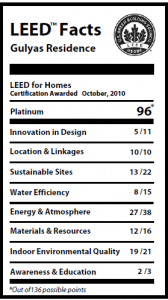
More than 10,000 homes across the U.S. have earned LEED certification through the LEED for Homes program, according to the U.S. Green Building Council (USGBC). LEED-certified home projects span the residential market, from multi- and single-family, to market rate and affordable housing.
“Reaching this milestone signifies the continued transformation of the home building industry towards high-performing, healthy homes that save home owners money,” said Nate Kredich, Vice President of Residential Market Development, U.S. Green Building Council. “Market leaders across the production, multifamily, affordable and custom home segments have recognized that there are green homes, and then there are LEED Homes, and they are acting accordingly.”
LEED for Homes is a national voluntary certification system that promotes the design and construction of high-performance green homes that use less energy and water and fewer natural resources; create less waste; and are healthier and more comfortable for the occupants. Since its launch in 2008, 10,161 homes have certified with over 38,000 additional units in the pipeline.
The 10,000th home to earn LEED certification was Tacoma Housing Authority’s 91-unit development, Salishan 7 in Washington. Salishan 7, built by Walsh Construction Company, is the first federally funded HOPE VI Redevelopment project to achieve LEED Platinum. The project was built within an affordable budget, and was designed to be at least 30% more energy efficient than the average home, effectively removing 27 homes from Tacoma Power’s electrical grid.
“We are proud to be a part of the community of over 10,000 homes that have committed to excellence through the LEED for Homes program,” said Michael Mirra, Executive Director, Tacoma Housing Authority. “Our LEED Platinum housing projects are less expensive to operate and are healthier inside, which means a world of difference to our residents.”
Nationally recognized market leaders such as McGuyer Homebuilders, Inc (production homes) in Dallas, Tex., Fore Property (multifamily) and dozens of Habitat for Humanity affiliates (affordable) are just a few of the organizations committing to LEED certification across the country.
Supporting the growth of the LEED for Homes program is the robust and dedicated network of LEED for Homes Providers; a community of nearly 400 LEED AP Homes credential holders, helping meet the need for knowledgeable green home building professionals; and a growing number of LEED for Homes Green Raters. Additionally, the USGBC recently launched its LEED for Homes Scoring Tool for builders to self-evaluate their home construction projects to see how close they are to LEED certification. This simple web-based application makes the program even more accessible to builders and homeowners.
Work with to help make your next LEED project a success.
Habitat for Humanity Kent County Chapter has been a leader and pioneer in the field when it comes to affordable and sustainable housing. In 2006, they built the nation’s first affordable LEED certified home under the LEED for Homes pilot project. Due the success of the first home, Habitat for Humanity Kent Co made an innovative commitment in 2007 – that future families would live in homes built to minimum LEED Silver Certification. Currently, they have surpassed the Silver level and have progressed to LEED Gold Certified Homes as their new standard house.
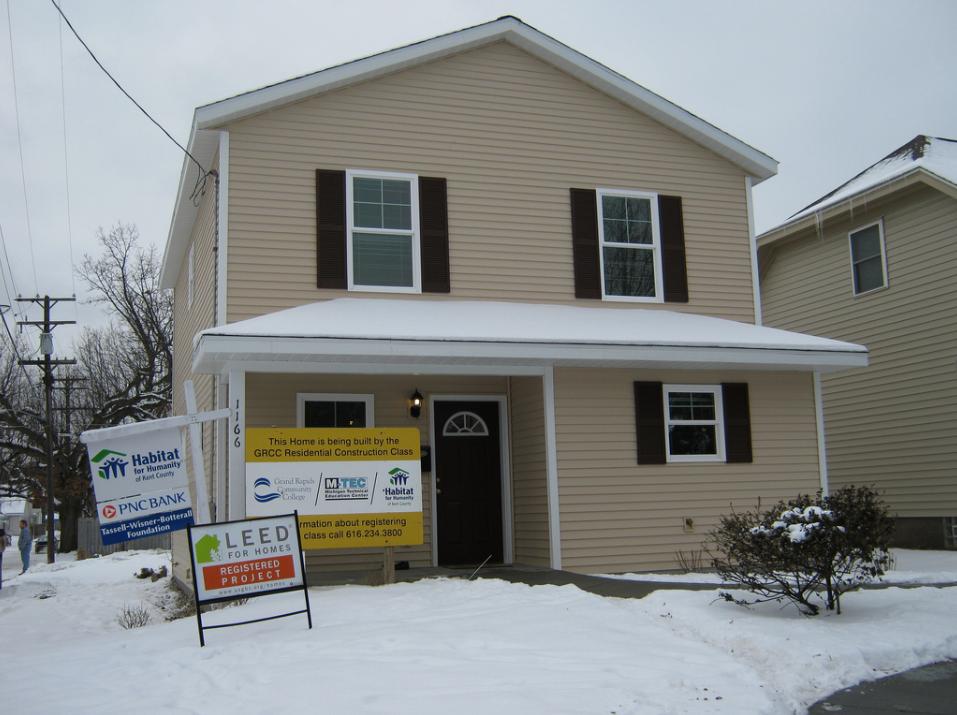
View/Download Complete project profile with LEED score and checklist here.
The Lee House was deconstructed and rebuilt after a fire had burned down the original home (see below). Habitat partnered with GRCC Tassell M-TEC students and instructor Duane McIntyre to build this 5-bedroom two story “Gervais” plan. It is “ZeroStep Certified” to be accessible, and also achieved LEED for Homes Gold Certification. Its 52 Home Energy Rating System score makes this one of Habitat Kent County’s most energy efficient home to date.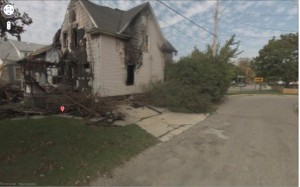
To date Habitat for Humanity Kent County has achieved great strides with LEED certification. They have built over 300 homes since they started in Kent County and certified 68 of those homes under the LEED rating system. They have registered 83 as of March 31st 2011 (with more to come!).
LEED Gut Rehabs of existing homes: 19
Average HERS score: 62.1
New Construction LEED Homes: 49
Average HERS score: 61.7
Average Square foot of Conditioned floor area: 1,750
This Habitat affiliate has built to the LEED standard in cities such as Sparta, Grand Rapids, Wyoming, Allendale, Cutlerville, Wayland all in Kent County, Michigan.
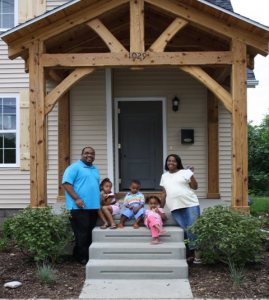 The latest home was a total gut-rehab project, made possible by the City of Grand Rapids and HUD via the Neighborhood Stabilization Project (NSP). It has achieved the coveted LEED for Homes Gold certification and will offer the hard-working Lee family a very energy efficient home.
The latest home was a total gut-rehab project, made possible by the City of Grand Rapids and HUD via the Neighborhood Stabilization Project (NSP). It has achieved the coveted LEED for Homes Gold certification and will offer the hard-working Lee family a very energy efficient home.
A unique post and beam Generations timber frame porch made from reclaimed power poles will grace the front of this home– easily the most challenging rehab project HFHKC has undertaken.
View/Download Complete project profile with LEED score and checklist here.
Due to Habitat for Humanity of Kent Counties commitment to LEED certification, they have been able to attract many more sponsors, donors and volunteers. They have also been able to achieve some great accomplishments.
Deconstruction of homes literally saves tons of usable materials and items from heading to the landfill. These materials are re-sold at the Habitat ReStore for a profit to build other homes.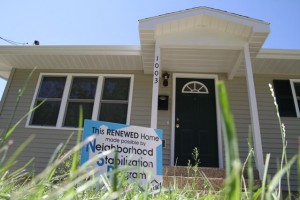
Thirty young construction students were educated in current green building practices and upon graduation, will bring those skills onto the local construction scene.
Habitat discovered that it costs approximately $8000 more to incorporate green building and zero-step entry into a Habitat home building per house, and that the long-term benefits to the family and the environment easily justify the expense.
It is estimated (based on their earliest LEED Homes) that annual savings costs for electric, water, and heating will be at least $1,000 per home per year. The extra money available every month eases the hard decision “food or heat?” for families who live close to the poverty line.
Over the life of each homebuyer’s 25 year mortgage, the savings equates to $25,000 at minimum – money a family is able to invest into strengthening their future.
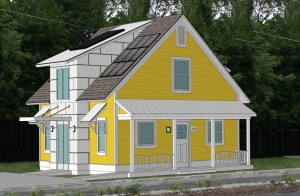 The future looks bright for Habitat for Humanity and Green Building. They now have LEED Platinum and Zero Energy / Net Zero homes under-construction. They are partnering with over a dozen organizations to continue revitalization efforts in the Wealthy Heights Neighborhood of Grand Rapids. They may be looking towards LEED ND certification for their neighborhood redevelopment plans.
The future looks bright for Habitat for Humanity and Green Building. They now have LEED Platinum and Zero Energy / Net Zero homes under-construction. They are partnering with over a dozen organizations to continue revitalization efforts in the Wealthy Heights Neighborhood of Grand Rapids. They may be looking towards LEED ND certification for their neighborhood redevelopment plans.
GreenHome Institute
ATTN José Reyna
1451 Lake Drive SE, #6484
Grand Rapids, MI 49516
Tel: (616) 458-6733
Email: info@greenhomeinstitute.org
